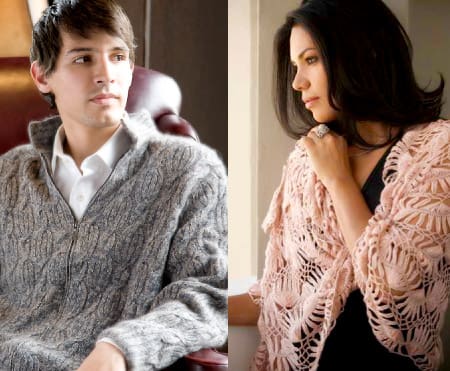
The quest for the world’s most exquisite and exotic animal fibre spawns a mini-empire of yarns, textiles and knitwear based in a secluded Canadian town.
The quest for the world’s most exquisite and exotic animal fibre spawns a mini-empire of yarns, textiles and knitwear based in a secluded Canadian town.
IKHUAK, CANADA – Mother Nature must enjoy watching mankind go to extraordinary lengths to reap her most precious bounty. Gold and diamonds take us on a treacherous journey into the bowels of the earth, while collecting crocodile and snake skin comes with hazards of its own – ferocious teeth, gruesome swamps and toxic venom, to mention but a few. Textiles are no different. The better the yarn, it seems, the more inhospitable the terrain from which it originates.
It was in the soaring Himalayas and the arid Anatolian plateau where European weavers discovered that the fleece of certain goat breeds — namely, cashmere, pashmina and angora — was stronger, warmer and softer than their native sheep’s wool. The bar was then raised to reveal even finer fibres from South American alpaca, vicuna and guanaco, llama-like creatures that, not surprisingly, roam the oxygen-deprived altiplano region of the jagged Andes Mountains.
Whether for their novelty factor or for their exceptional properties, man will go to the ends of the earth in pursuit of luxury materials. Just ask the entrepreneur who trademarked the next big thing in exotic animal fibres.
Fernando Alvarez was brought up just south of the Equator in the Cuzco region of Peru where the Incas once raised vicunas, spinning the soft fleece into lavish garments for royals and nobility. Alpaca dotted the valleys where Alvarez’s family owned large tracts of land before agrarian reform and political unrest swept the country. The most luxurious fleeces known to the fashion industry were on his doorstep, and in his blood. Yet, Alvarez packed up for the other side of the world in search of something even more precious.
“I was a young person looking for something promising,” he says. “We originally worked with alpaca but I soon realised that the only way I could make a real difference for our business — and in the industry in general — was to obtain the absolute best fibres possible.”
The animal making his fortune these days lives in the Arctic circle, about as close as you can get to the North Pole by land — nearly 90 degrees north of where he began his quest in Peru.
“Back then it was the beginning of the protection of the vicuna. So when a scientist friend of mine at the University of Saskatchewan who knew I was on the lookout for something new asked me to experiment with the fibre of an arctic animal he was researching, I gave it a try.”
In the frozen wastelands of the Canadian tundra, each spring herds of the oomingmak (muskox) shed a super soft, downy fleece that native Inuit nomads have collected for centuries as insulation in traditional clothing. Its shorter underwool hair is what is locally known as qiviut in Inuktitut, the Inuit’s main language, or as qiviuq in Inuinnaqtun, the dialect spoken where most of the muskox live today. Clumps of the fleece are either gathered from the ground where the wild muskox moult in the spring or combed out from the pelt after one has been culled for food during a strictly regulated hunting season.
It is estimated that there are only 140,000 of the prehistoric-looking beasts worldwide, two thirds of which live on just one remote island of the Canadian Arctic Archipelago — Banks Island, home to 120 people and a mercilessly long winter. Through his company, Jacques Cartier Clothier, Alvarez secured a supplier agreement about twelve years ago with the semi-autonomous Inuvialuit tribe who inhabit the Northwest Territories where Banks Island is located.
Apart from a few muskox that were recently introduced to a mountainous patch of Norway, one peninsula in Siberia, the northernmost tip of Greenland and a scattering of farms in Alaska, the animal is essentially a Canadian resource — meaning that Alvarez’s deal with the Canadian Inuits now translates to a tight grip on the supply of the qiviuq fleece.

Several studies have demonstrated that qiviuq is substantially stronger and eight times warmer by weight than most sheep’s wool. It is being touted as “the new vicuna”, “softer than cashmere”, and “the most luxurious animal fibre out there” by many textile industry commentators. Besides its rarity, qiviuq’s value, like all woollen fibres, is also determined by a measurement of its diameter in microns (one thousandth of a millimetre). The finer the fibre, the better the yarn it yields. Measurements of all varieties of animal fibre vary according to the grade of individual bales of fleece, rendering a definitive ranking of animal fibres very difficult.
But according to identification guidelines published by the U.S. Fish & Wildlife Service, which is responsible for inspecting exotic animal products to determine whether fibres or skin from endangered species (like the Shahtoosh antelope) have been used, qiviuq ranges between 11.4 and 15.3 microns, making it finer than cashmere, pashmina, merino or alpaca – and on par with some vicuna. Alvarez concludes that, since vicuna fibre production has recently overtaken that of qiviuq, the latter is now the most precious and possibly the most expensive in the world — though he declined to disclose the price his company pays.
Sigrun Robertson, executive director of Oomingmak Musk Ox Producers’ Co-operative in Alaska, a collective of about 200 Alaskan Natives who earn a supplemental income to their mostly subsistence lifestyle by hand knitting scarves and hats under the brand name Qiviut, believes that qiviuq’s reputation as the most expensive animal fibre on the market may well be true. “We pay about $150 per pound for raw fibre combed from domesticated muskox,” she says.
By comparison, a report in International Wildlife magazine suggests that since the vicuna was downgraded in 1987 by the Convention on International Trade in Endangered Species, raw vicuna fleece prices have stagnated at around $140 per pound.
Pascaline Wilhelm, fashion director of the leading Paris fabric fair Première Vision, suggests that demand for qiviuq fabrics may already exceed the current supply, further heightening interest in the fibre among exhibitors and buyers alike.
“There is definitely a buzz,” she says. “Some of the other English and Italian weavers are very interested in qiviuq; but I’ve understood that [Alvarez’s partners] have exclusive contracts, so qiviuq fabrics are not so readily available at the fair. The muskox fibre is a wonderful story and perfectly in tune with these times when anti-globalisation is a growing trend that keeps us looking for something local and unusual.”
In 2001, Alvarez trademarked a variation of the native word for the fleece, “Qiviuk”, and developed a private label of fashion and lifestyle knits under the same name. Qiviuk boutiques were opened in two of Fairmont’s luxury ski resort hotels in Canada and, last year, in New York’s The Plaza Retail Collection on Fifth Avenue.

Qiviuk branded yarn is spun in Italy by the Filatura di Trivero mill and woven into fabric for Qiviuk products by Carlo Piacenza. The renowned Anglo-French luxury fabric merchant, Dormeuil, wholesales Qiviuk fabrics to international fashion houses.
“Since we released the world’s first hyper-luxury suiting fabric containing the precious Qiviuk fibre in 2007 — what we call ‘Royal Qiviuk’ — we have seen our most discerning clientele become increasingly aware of what has been one of Dormeuil’s best-kept secrets,” says Dormeuil’s head of UK sales, Patrick Bunting “Most of the claims that I have heard about qiviuq’s properties are true and certainly from my experience, it’s a near perfect fibre. I can honestly say that it’s ‘the new vicuna’.”
While Bunting declined to divulge the brands that buy Dormeuil’s Royal Qiviuk fabric, he hinted that, “it would be safe to say that the tailors of Savile Row and couture houses of Paris, Japan and Italy all have used Royal Qiviuk.”
Late last year, Brioni announced it had acquired the exclusive rights to one of Dormeuil’s proprietary fabrics, dubbed Vanquish II, woven from qiviuq, pashmina and vicuna. Just 150 of the suits, priced up to $43,000, were produced and sold worldwide.
Alvarez counts Hermès and Valentino among the luxury brands that have used fabrics woven from Qiviuk yarns; but, like Brioni’s suits, the fabrics they use are typically blended with other “lesser” luxury fibres since pure qiviuq fabrics would be prohibitively expensive.
Rapidly establishing an oligopoly around an already rare fibre with an exotic narrative behind it, Alvarez has come to dominate the world’s distribution of a newly discovered luxury material, marketed as the ultimate textile fibre on three levels of the value chain: wholesaling yarns, supplying fabrics and retailing finished garments. Through strategic partnerships with mills and weavers, as well as a clever trademark of the fibre’s colloquial name, he has cornered the market, turning the mythical golden fleece of the North into a highly profitable business.
Robb Young is Managing Editor










